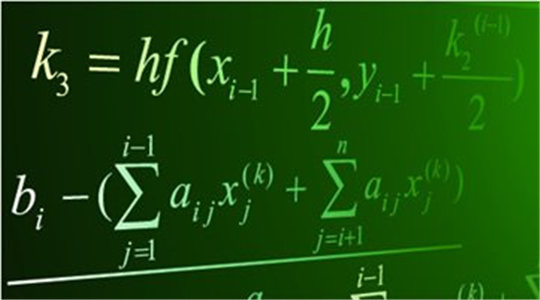
当前课程知识点:微积分-2 > Chapter 4 Differentiations of Multivariable Functions 多元函数微分学 (second part) > Unit 4 Completeness and Connectness (完备性与连通性) (section 1) > Completeness and Connectness (完备性与连通性) (section 1)
同学们 你们好
欢迎再次来到MOOC在线课程微积分
在前面的课程中呢我们已经学习了
欧氏空间里边简单的拓扑结构
比如开集闭集的定义
集合的闭包 内部 边界等等
那在这一讲中呢
我们要进一步深入研究欧氏空间
主要呢学习欧氏空间的完备性
并且呢我们要介绍什么是紧致集
而且要引出一个著名的定理
就是
Bolzano-Weierstrass 定理
最后呢我们还要对连通性简单的介绍一下
好的 下面呢 我们从第一小节讲起
Chapter 4
Differentiations of Multivariable Functions
多元函数微分学
Unit 4
Completeness and Connectedness
完备性与连通性
Section 1
Completeness of E^3
欧氏空间的完备性
同学们
前面我们已经非常熟悉
欧氏空间的点集拓扑结构了
那么有了这些基础呢我们就可以讨论它的
极限的概念
我们首先呢要讨论序列极限
The limit of a sequence
A sequence
比如说我们把这个sequence呢 记成{p_n}
注意其中每一个p啊
它都是欧氏空间E^3中的某一个向量
因此呢我们在它的上面画了一个箭头
它的指标呢 仍然是小n
n从1开始 一直到无穷
这样一个点列呢 就叫做一个序列
A sequence
Such a sequence is said to have the limit point l
这个序列我们称它的极限是某一个点
这个点呢仍然是一个向量的端点
因此我们把它用l加一个箭头来表示
如果满足什么条件呢
If 注意下面我们用的就是ε大N语言
For any ε positive
there exists some N which is a integer
such that l minus p_k and then take norm
will be less than ε
for any k bigger than big N
这个叙述方式和我们在R中
定义点列的极限的时候的定义方式非常的相像
也就是说 任意ε大于零
存在着某一个指标大N
使得只要任何一个指标小k 它大于大N的话
那么从这个小k开始
l和p_k之间的距离就永远小于ε
这里呢因为是在E^3中考虑
所以距离是用norm 也就是范数来定义的
那么表达极限的符号呢
和我们在一元微积分的情形呢
也是基本一致的
我们用这样的符号来表示序列p_n的极限是l
也就是
limit as n goes to infinity p_n equals l
如果这种情况发生
我们就称序列p_n是一个收敛的点列
So we say this {p_n} is a convergent sequence
那么
关于极限呢我们可以换另外一种方式来定义
就是这样写
{p_n} such a sequence converges to l
if and only if
换成一种等价的方式 是这样写的 就是说
For any r positive
任取一个半径r大于0
则 下面这个集合是一个有限点集
注意前边这个集合
我们在它的前面啊 画了一个井号
井号呢 读作sharp
它表示一个集合里边的势
也就是它元素的个数
这个集合是什么呢 我们看一下
就是B(l,r)
and then take complement
首先取以l为中心 r为半径的开球
这个开球的余集 交上这个序列的集合
也就是说 这个集合是什么呢
是全体距离l大于r的那些
序列中的元素所构成的集合
它必须是一个有限集
Less than infinity 就是这个意思
这个写法呢非常的简略
但是它的含义和我们刚才用
ε大N语言定义的方式呢是完全一致的
同学们可以自己思考一下
我们还是强调一下这个井号这个语言呢
它表示
number of elements in a set
这个呢在别的集合论的书上呢
可能有不同的符号
现在呢 我们就用这样的符号
好的 我们看一个简单例子吧
比如说
p_n equals cos 1 over n sin 1 over n zero
这是一个点列
其中n呢从1跑到无穷
它有极限吗
实际上它是有的
The limit of p_n equals one zero zero
也就是它的极限啊是这个点 就是(1,0,0)
那么我们可以发现
实际上取p_n的极限的过程啊
本质上就相当于逐坐标去找它们的极限
你看 cos n分之1 它的极限就是1
sin n分之1 极限就是0
0的极限当然还是0
我们再看一个例子
比如
p_n equals cos n sin n zero
n呢还是从0变到无穷
那么这样的序列是否有极限呢
实际上
This {p_n} does not converge to any point in E^3
也就是这样的一个序列它是一个发散的点列
它不是收敛的
这个原因呢 很简单
因为这个p_n 我们观察它的每一个分量的话
cos n 当n趋于无穷的时候 极限不存在
sin n趋近于无穷的时候 极限也不存在
因此呢 这个p_n
不可能收敛到任何一个点
接下来我们还需要另外一个定义
A sequence of points x_n in E^3
is said to be Cauchy sequence
我们现在要定义什么叫做柯西点列
那么我们考虑点列呢
把它记作{x_n}
它是欧氏空间E^3中的一个点列
If for any ε positive there exists some N
存在某一个指标大N
从大N开始都满足这样的条件
Such that x_p minus x_q
and then take norm is less than ε
for any p q bigger than big N
从大N开始 任意的指标
它们对应的点x_p 和x_q之间的距离呢
永远小于ε
这个和我们在一元微积分时候
讨论数列的柯西点列的性质
是一模一样定义的
因此呢这个定义呢 完全没有什么新的地方
同学们可以很容易理解
好的 下面我们看一下
关于柯西点列一个重要的判据就是
柯西准则
Cauchy Criterion
柯西准则呢 它实际上也是
E^3欧氏空间的完备性的一种表达
请看 柯西准则是这么说的 它说
A sequence of points in E^3 converges
if and only if it is a Cauchy sequence
也就是说 欧氏空间E^3中的一个点列
它是收敛的
充分必要条件是这个点列呢本身是柯西列
柯西列的意义就在于
当我们事先并不知道它收敛到某一个点的时候
来判定它是否柯西
也就是它是否收敛
好的 同学们
下面我们使用柯西准则呢来证明一件事情
If S contained in E^3 is open and closed
假设某一个集合S 它是E^3中的一个子集
这个集合呢 它既是开集又是闭集
那么 结论是说
Either S is the entire E^3 or S is empty
也就是说 S要么一定是全体空间
要么S就是空集
换言之 既开又闭的集合啊 只有空集和全集
那这是为什么呢
这个证明啊 我们是需要用到柯西准则的
下面呢 我们来看一下
这个证明比较长
同学们呢 一定要仔细地思考其中的每一步
我现在呢 给同学们
简略的解说一下其中概要的过程
We adopt a negative approach
我们呢用反证法
negative approach
If S is not empty
我们无妨假设S不是空集
那么下面呢 我们就要证明S一定是全集E^3
如果S不是E^3
那么S的余集呢也不是空集
这就是我们的反证法的假设
如果这个假设最后证明是有矛盾的
那么说明我们的假设是不对的
只能S等于E^3
我们就证明了我们的结论
好的现在呢 我们还是在这个假设下
就S既不是空集 S的余集也不是空集
我们来看看会导出怎样的矛盾
Then one can take some
A naught in S and B naught in S^c
因为这两个集合 S S^c都不是空集
我们可以在它们中分别取两个点
一个记作A_0 一个记作B_0
Consider the mid point
这个中点呢 可以记作二分之一A_0加B_0
因为啊 A_0 B_0是两个向量
那么向量相加再除2恰好表示
这两个向量中间那个中点位置
好的
if it belongs to S we denote it by A_1
and let B_1 equals B_0
如果刚才这个中点呢属于S的话
我们就把这个中点记作A_1
而把B_1记作B_0
否则
也就是说刚才这个二分之一A_0加B_0
如果属于S^c的话
我们就把它记作B_1
而把A_1记作A_0
这样的话 我们从A_0 B_0出发
就得到了A_1 B_1
Repeat this process
也就是说从A_1 B_1再重复刚才的过程
得到A_2 B_2 so on
We get two sequences {A_n} and {B_n}
我们就得到两个序列
这个点列{A_n}啊 它就永远包含在S中
而{B_n}呢永远包含在S的余集中
It is easy to see that
they are all Cauchy sequences
and hence they converge
根据刚才构造啊
这个{A_n} {B_n}呢就是柯西点列
因为它们之间的距离呢 越来越短 越来越短
而且是成2的n次方递减的
因此呢 它一定是柯西点列
于是我们断定
{A_n} {B_n} they both converge
它们两个都是收敛点列
也就是说 {A_n} {B_n} 他们两个都有极限
但是 我们要注意这样一个事情
就是 A_n minus B_n
The norm of A_n minus B_n is approaching zero
A_n 和 B_n 之间的距离呢 也是趋近于零的
这是根据构造我们看出来的
因此呢
{A_n} and {B_n} must converge to the same point
也就是说{A_n} {B_n}它一定会收敛到同一个点
我们就把这个点呢记作C
Denote it by C which is in E^3
好了 现在我们考虑 C在哪里
Now S being closed implies C is in S
因为我们假设了 S是既开又闭的
所以C作为A_n的极限点 一定是S中的元素
同样的原理
因为我们假设 S是开集 所以S^c是闭集
那么
S^c being closed implies C must also be in S^c
于是现在就矛盾了
因为我们在S中找到了一个点C
在S^c中呢也找到了一个点C
这是不可能的
Contradiction
contradiction就告诉我们
原来的假设是不对的
于是我们就证明了这样的一个命题
下面我们再看另外一个定义
Definition 1.7
A set S contained in E^3 is said to be compact
Compact的汉语意思是紧集或者紧致集
If S is closed and bounded
如果这个集合S
它既是一个闭集又是一个有界集
我们就把这样的S叫做紧集或紧致集
Here S being bounded means
我们要回顾一下所谓一个集合有界是什么意思
也就是说 存在着某一个数M大于0
使得x的
norm is always less than M
for any x in S
也就是说整个这个集合S啊
它包含在一个球中
这个球呢以原点0为中心 大M为半径
这样的集合S就叫做有界集
同学们 紧致集是一种非常重要的集合
那么它拥有非常好的性质
我们来看一下
Theorem 我们有这样一个定理 它说
Let S be a compact set
假设S是E^3中的某一个紧集
那么
from every open covering of S
one can extract a finite covering
这句话它的意思是这样的
就是
任意S的开覆盖中总能找到一个有限子覆盖
什么意思呢
In other words
if every U_i where i is in some index set λ
is open and S is contained in the union of U_i
这句话的意思是说
如果我们找到了集合S的某个开覆盖
这个开覆盖中的元素呢就是一些开集U_i
而它的U_i呢都带着一个指标i
i是某一个指标集
这个指标集呢 可以是任意形式的集合
可以是无限多 可数 不可数 等等
好 S找到这样一个开覆盖
那么
there always exists some
U_i_1 U_i_2 and U_i_n
也就是说我们从这个指标集中
总能找到有限个指标
i_1 到i_n 使得相应的那些U_i
就构成了S的一个覆盖
也就是说我们只需要有限个
刚才这个覆盖中的元素
就可以把S整体盖出来
这就是从一个任意的覆盖中取有限次覆盖
这样一个过程
这是个非常重要的性质
这也是紧集所拥有的独特的性质
关于欧氏空间E^3的完备性呢
我们还有另外一个重要的定理
这个定理的名称呢叫做
Bolzano-Weierstrass 定理
它呢也是描述完备性的一种形式
我们来看一下
Each bounded sequence in E^3
has a convergent subsequence
这句话的意思是说
任何欧氏空间E^3中的有界点列
总是存在收敛的子列
In other words if {p_n} n goes from one to infinity
is a sequence in E^3
and there exists some M positive
such that every p_n the norm of that p_n
is less than M
then there exists a subsequence p_n_k
k from one to infinity which is convergent
也就是说 如果{p_n}是一个有界的点列
那么我们可以从{p_n}中找到一个子列
这子列呢 记作{p_n_k} 现在指标变成了k
使得{p_n_k}
当k趋近于无穷的时候它存在一个极限
因此呢 它是收敛的
这就是从一个有界点列中选取收敛子列的过程
这件事情能完成就说明这个空间E^3是完备的
这就是所谓的
Bolzano-Weierstrass 定理
这也是欧氏空间一个非常重要的特点
-Introduction (课程介绍)
-Unit 1 Definition of Improper Integrals (广义积分的定义)(section 1)
--Definition of Improper Integrals (广义积分的定义)(section 1)
--Exercises-1-1-1
-Unit 1 Definition of Improper Integrals (广义积分的定义)(section 2)
--Definition of Improper Integrals (广义积分的定义)(section 2)
--Exercises-1-1-2
-Unit 2 Examples of Improper Integrals (广义积分的例子)
--Video-1-2 Examples of Improper Integrals (广义积分的例子)
--Exercise-1-2
- Unit 3 Tests of Convergence(收敛性判别)(section 1)
--Tests of Convergence(收敛性判别)(section 1)
--Exercises-1-3-1
- Unit 3 Tests of Convergence(收敛性判别)(section 1)--作业
- Unit 3 Tests of Convergence(收敛性判别)(section 2)
--Tests of Convergence(收敛性判别)(section 2)
--Exercises-1-3-2
- Unit 3 Tests of Convergence(收敛性判别)(section 2)--作业
-Unit 4 Absolute Convergence and Conditional Convergence (绝对收敛和条件收敛)
--Absolute Convergence and Conditional Convergence (绝对收敛和条件收敛)
--Exercise-1-4
--1-4讲义
-Test1
-Unit 1 Infinite Series and Their Convergence(无穷级数及其收敛性)
--Infinite Series and Their Convergence (无穷级数及其收敛性)
--Exercises-2-1
--2-1讲义
-Unit 2 Absolute Convergence and Conditional Convergence (绝对收敛与条件收敛)
--Absolute Convergence and Conditional Convergence (绝对收敛与条件收敛)
--Exercises-2-2
--2-2讲义
-Unit 3 More Tests for Convergence (更多的收敛性判别法)(section 1)
--More Tests for Convergence (更多的收敛性判别法)(section 1)
--Exercises-2-3-1
-Unit 3 More Tests for Convergence (更多的收敛性判别法)(section 2)
--More Tests for Convergence (更多的收敛性判别法)(section 2)
--Exercises-2-3-2
-Unit 3 More Tests for Convergence (更多的收敛性判别法)(section 3)
--More Tests for Convergence (更多的收敛性判别法)(section 3)
--Exercises-2-3-3
--2-3讲义
-Test2
-Unit 4 Sequences and Series of Founctions(函数项数列与函数项级数)(section 1)
--Sequences and Series of Founctions(函数项数列与函数项级数)(section 1)
--Exercises-2-4 (section 1)
-Unit 4 Sequences and Series of Founctions(函数项数列与函数项级数)(section 2)
-- Sequences and Series of Founctions(函数项数列与函数项级数)(section 2)
--Exercises-2-4 (section 2)
--2-4讲义
-Unit 5 Uniform Convergence(一致收敛性)(section 1)
--Uniform Convergence(一致收敛性)(section 1)
--Exercises-2-5(section 1)
-Unit 5 Uniform Convergence(一致收敛性)(section 2)
--Uniform Convergence(一致收敛性)(section 2)
--Exercises-2-5(section 2)
--2-5讲义
-Unit 1 Power Series (幂级数)(section 1)
--Power Series (幂级数) (section 1)
--Exercise-3-1(section 1)
-Unit 1 Power Series (幂级数)(section 2)
--Power Series (幂级数)(section 2)
--Exercise-3-1 (section 2)
--3-1讲义
-Unit 2 Expansion of Functions in Power Series (函数的幂级数展开)
--Expansion of Functions in Power Series(函数的幂级数展开)
--Exercise-3-2
--3-2讲义
-Unit 3 Fourier Expansion (Fourier级数展开) (section 1)
--Fourier Expansion(Fourier级数展开)(section 1)
--Exercise-3-3(section 1)
-Unit 3 Fourier Expansion (Fourier级数展开) (section 2)
--Fourier Expansion(Fourier级数展开)(section 2)
--Exercise-3-3(section 2)
--3-3讲义
-Unit 4 Convergence of Fourier Series(Fourier 级数的收敛性)(section 1)
--Convergence of Fourier Series(Fourier 级数的收敛性)(section 1)
--Exercise-3-4(section 1)
-Unit 4 Convergence of Fourier Series(Fourier 级数的收敛性)(section 2)
--Convergence of Fourier Series(Fourier 级数的收敛性)(section 2)
--Exercise-3-4(section 2)
--3-4讲义
-Unit 5 Other Forms of Fourier Series(其他形式的Fourier级数)
--Other Forms of Fourier Series(其他形式的Fourier级数)
--Exercise-3-5
--Test3
--3-5讲义
-Unit 1 Euclidean Space (欧几里德空间) (section 1)
--Euclidean Space (欧几里德空间) (section 1)
--Exercise-4-1-1
-Unit 1 Euclidean Space (欧几里德空间) (section 2)
--Euclidean Space (欧几里德空间) (section 2)
--Exercise-4-1-2
-Unit 1 Euclidean Space (欧几里德空间) (section 3)
--Euclidean Space (欧几里德空间) (section 3)
--Exercise-4-1-3
--4-1讲义
-Unit 2 Curves and Surfaces (曲线与曲面) (section 1)
--Curves and Surfaces (曲线与曲面) (section 1)
--Exercise-4-2-1
-Unit 2 Curves and Surfaces (曲线与曲面) (section 2)
--Curves and Surfaces (曲线与曲面) (section 2)
--Exercise-4-2-2
-Unit 2 Curves and Surfaces (曲线与曲面) (section 3)
--Curves and Surfaces (曲线与曲面) (section 3)
--4-2讲义
-Unit 3 Point-Set Topology of E3 (E3中的点集拓扑) (section 1)
--Point-Set Topology of E3 (E3中的点集拓扑) (section 1)
--Exercise-4-3-1
-Unit 3 Point-Set Topology of E3 (E3中的点集拓扑) (section 2)
--Point-Set Topology of E3 (E3中的点集拓扑) (section 2)
--Exercise-4-3-2
-Unit 3 Point-Set Topology of E3 (E3中的点集拓扑) (section 3)
--Point-Set Topology of E3 (E3中的点集拓扑) (section 3)
--Exercise-4-3-3
--4-3讲义
-Unit 4 Completeness and Connectness (完备性与连通性) (section 1)
--Completeness and Connectness (完备性与连通性) (section 1)
--Exercise-4-4-1
-Unit 4 Completeness and Connectness (完备性与连通性) (section 2)
--Completeness and Connectness (完备性与连通性) (section 2)
--Exercise-4-4-2
--4-4讲义
-Unit 5 Continuous Multivariable Functions (连续多元函数) (section 1)
--Continuous Multivariable Functions (连续多元函数) (section 1)
--Exercise-4-5-1
-Unit 5 Continuous Multivariable Functions (连续多元函数) (section 2)
--Continuous Multivariable Functions (连续多元函数) (section 2)
--Exercise-4-5-2
-Unit 5 Continuous Multivariable Functions (连续多元函数) (section 3)
--Continuous Multivariable Functions (连续多元函数) (section 3)
--Exercise-4-5-3
--4-5讲义
-Unit 6 Partial Derivatives and Differentiability (偏导数与可微性) (section 1)
--Partial Derivatives and Differentiability (偏导数与可微性) (section 1)
--Exercise-4-6-1
-Unit 6 Partial Derivatives and Differentiability (偏导数与可微性) (section 2)
--Partial Derivatives and Differentiability (偏导数与可微性) (section 2)
--Exercise-4-6-2
-Unit 6 Partial Derivatives and Differentiability (偏导数与可微性) (section 3)
--Partial Derivatives and Differentiability (偏导数与可微性) (section 3)
--Exercise-4-6-3
--4-6讲义
-Unit 7 Jacobian Matrix and Directional Derivatives (雅克比矩阵与方向导数) (section 1)
--Jacobian Matrix and Directional Derivatives (雅克比矩阵与方向导数) (section 1)
-Unit 7 Jacobian Matrix and Directional Derivatives (雅克比矩阵与方向导数) (section 2)
--Jacobian Matrix and Directional Derivatives (雅克比矩阵与方向导数) (section 2)
--Exercise-4-7-1
--Exercise-4-7-2
-Unit 7 Jacobian Matrix and Directional Derivatives (雅克比矩阵与方向导数) (section 3)
--Jacobian Matrix and Directional Derivatives (雅克比矩阵与方向导数) (section 3)
--Exercise-4-7-3
-Unit 7 Jacobian Matrix and Directional Derivatives (雅克比矩阵与方向导数) (section 4)
--Jacobian Matrix and Directional Derivatives (雅克比矩阵与方向导数) (section 4)
--Exercise-4-7-4
--4-7讲义
-Test1
-Unit 8 Taylor's Theorem (泰勒定理) (section 1)
--Taylor's Theorem (泰勒定理) (section 1)
-Exercise-4-8-1
-Unit 8 Taylor's Theorem (泰勒定理) (section 2)
--Taylor's Theorem (泰勒定理) (section 2)
-Exercise-4-8-2
-Unit 8 Taylor's Theorem (泰勒定理) (section 3)
--Taylor's Theorem (泰勒定理) (section 3)
--4-8讲义
-Unit 8 Taylor's Theorem (泰勒定理) (section 3)--作业
-Unit 9 Applications of Gradients (梯度的应用) (section 1)
--Applications of Gradients (梯度的应用) (section 1)
-Unit 9 Applications of Gradients (梯度的应用) (section 2)
--Applications of Gradients (梯度的应用) (section 2)
--Exercise-4-9-2
--4-9讲义
-Unit 1 Multiple Integrals (重积分) (section 1)
--Multiple Integrals (重积分) (section 1)
-Unit 1 Multiple Integrals (重积分) (section 2)
--Multiple Integrals (重积分) (section 2)
--Exercise-5-1-2
-Unit 1 Multiple Integrals (重积分) (section 3)
--Multiple Integrals (重积分) (section 3)
--Exercise-5-1-3
--5-1讲义
-Unit 2 Triple Integrals (三重积分) (section 1)
--Triple Integrals (三重积分) (section 1)
--Exercise-5-2-1
-Unit 2 Triple Integrals (三重积分) (section 2)
--Triple Integrals (三重积分) (section 2)
--Exercise-5-2-2
-Unit 2 Triple Integrals (三重积分) (section 3)
--Triple Integrals (三重积分) (section 3)
--Exercise-5-2-3
--5-2讲义
-Unit 3 Line Integrals (曲线积分) (section 1)
--Line Integrals (曲线积分) (section 1)
--Exercise-5-3-1
-Unit 3 Line Integrals (曲线积分) (section 2)
--Line Integrals (曲线积分) (section 2)
--Exercise-5-3-2
--5-3讲义
-Unit 4 Surface Integrals (I) (第一型曲面积分) (section 1)
--Surface Integrals (I) (第一型曲面积分) (section 1)
--Exercise-5-4-1
-Unit 4 Surface Integrals (I) (第一型曲面积分) (section 2)
--Surface Integrals (I) (第一型曲面积分) (section 2)
--Exercise-5-4-2
-Unit 4 Surface Integrals (I) (第一型曲面积分) (section 3)
--Surface Integrals (I) (第一型曲面积分) (section 3)
--Exercise-5-4-3
-Unit 5 Surface Integrals (II) (第二型曲面积分) (section 1)
--Surface Integrals (II) (第二型曲面积分) (section 1)
-Unit 5 Surface Integrals (II) (第二型曲面积分) (section 2)
--Surface Integrals (II) (第二型曲面积分) (section 2)
--5-4讲义
-Unit 5 Surface Integrals (II) (第二型曲面积分) (section 3)
--Surface Integrals (II) (第二型曲面积分) (section 3)
--Exercise-5-5-1
--5-5讲义
-Unit 6 Some Theorems of Line and Surface Integrals (曲线与曲面积分的几个定理) (section 1)
--Some Theorems of Line and Surface Integrals (曲线与曲面积分的几个定理) (section 1)
--Exercise-5-6-1
-Unit 6 Some Theorems of Line and Surface Integrals (曲线与曲面积分的几个定理) (section 2)
--Some Theorems of Line and Surface Integrals (曲线与曲面积分的几个定理) (section 2)
-Unit 6 Some Theorems of Line and Surface Integrals (曲线与曲面积分的几个定理) (section 3)
--Some Theorems of Line and Surface Integrals (曲线与曲面积分的几个定理) (section 3)
--Exercise-5-6-2
--Exercise-5-6-3
--5-6讲义
-Unit 6 Some Theorems of Line and Surface Integrals (曲线与曲面积分的几个定理) (section 4)
--Some Theorems of Line and Surface Integrals (曲线与曲面积分的几个定理) (section 4)
-Unit 7 Field Theory (场论) (section 1)
--Field Theory (场论) (section 1)
-Unit 7 Field Theory (场论) (section 2)
--Field Theory (场论) (section 2)
--Exercise-5-7-1
-Unit 7 Field Theory (场论) (section 3)
--Field Theory (场论) (section 3)
-Unit 7 Field Theory (场论) (section 4)
--Field Theory (场论) (section 4)
--Exercise-5-7-2
--Test5
--5-7讲义




